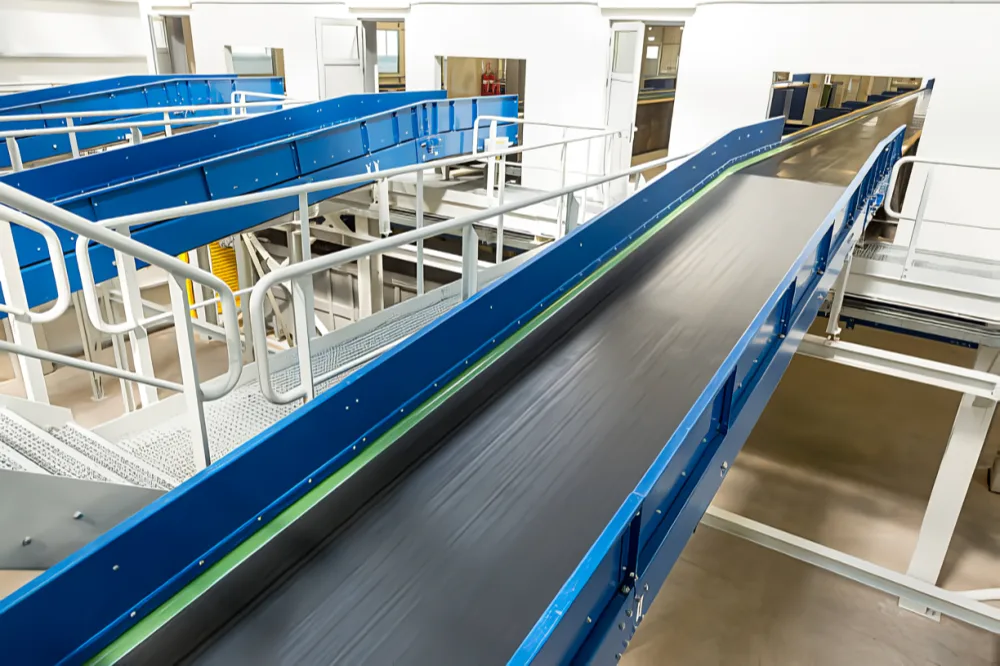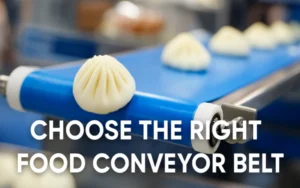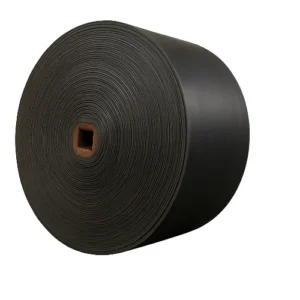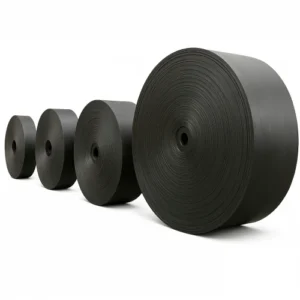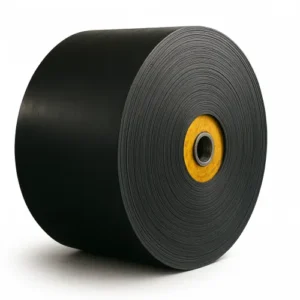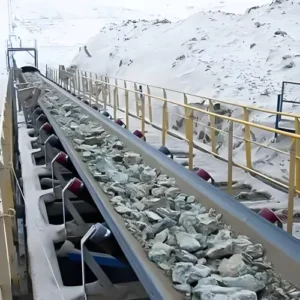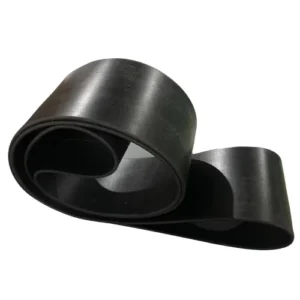1. Introduction: the modernization of automated conveyor belts
Automated conveyor systems have become a cornerstone of modern industry across all aspects of manufacturing, logistics, and material handling.Automated conveyor systems not only increase productivity, but also greatly optimize the entire production process by reducing human error. These systems simplify complex material handling processes into automated operations, ensuring that materials are transferred smoothly, safely and accurately from one workstation to another. As technology continues to advance, automated conveyors are expanding their application from traditional manufacturing to more industries such as food processing, electronics assembly, and e-commerce warehousing.
Like a seamless system of gears, automated conveyors deliver unparalleled operational efficiency. It’s not just a mechanization advancement, it’s the heartbeat of the industry – every precise material transfer drives the blood flow of the global supply chain. Today, manufacturing companies are not just looking for productivity gains, but are also focusing on optimizing conveyor belt systems to achieve flexible production as well as smart factory goals. Many companies are deploying advanced automation equipment to respond to lightning-fast changes in market demand.
While production lines used to move at “turtle speed,” today’s automated conveyor systems are like “freeway” speeds. This shift has not only dramatically reduced labor costs, it has also dramatically increased productivity. And, with the advent of Industry 4.0, automated conveyor systems have become an indispensable part of the global manufacturing industry, driving the industry forward at a rapid pace.
From a historical perspective, the evolution of conveyor belt systems is comparable to being part of the Industrial Revolution. At first, they were simple mechanical conveyors, but today, through the combination of automation and intelligent monitoring, automated conveyor systems have become highly sophisticated material transportation systems. In production lines that used to rely on a lot of manpower, automated systems are now able to operate seamlessly around the clock, increasing productivity without interruption.
Whether it’s in a logistics center or on the manufacturing floor, every technological advancement we see is quietly changing the way the industry operates. Perhaps the conveyor belt system of the future will not only be a core component of the factory, but will also become an important force to promote the upgrading of the industry as a whole, and it is expected that this change will be applied and explored in more industries.
Another highlight of automated conveyor belt systems is their adaptability and flexibility. The needs of various industries are becoming more and more complex, and companies require conveyor belt systems that can not only cope with different types of products, but also handle complex production rhythms and adjust according to real-time data. For example, in the e-commerce logistics industry, companies require warehouse systems that not only transfer goods, but also include intelligent sorting and inventory management, which is where automation conveyors come into their own.
More interestingly, automated conveyor systems have become the backbone of global logistics. As the saying goes, “time is money,” and today’s global supply chains demand speed and consistency. This means that organizations must rely on more technology to ensure that every aspect of logistics runs smoothly, and automated conveyor systems are an essential driver in this process.
It seems that these automated conveyor belt systems are not only changing the way materials are handled, but they are also completely reinventing the efficiency of modern manufacturing and logistics. As these technologies continue to evolve, we are in the midst of an unprecedented era of industrial automation, and the opportunities ahead seem endless.
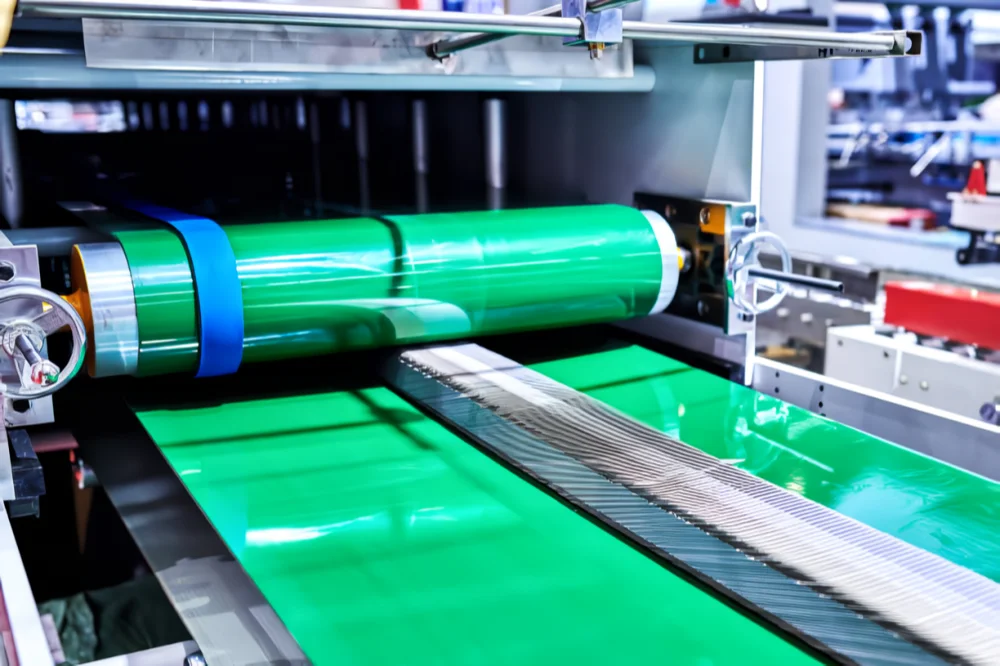
2. Modular design: increasing flexibility and scalability
In a complex industrial world, modular design is like a precision carving knife, capable of quickly and flexibly carving out pieces and functions to suit any need. For automated conveyor systems, modularity is not just an option, it is a strategy – giving companies unlimited capacity for adaptation and expansion. Modular design makes the individual parts of a conveyor system into components that can be freely disassembled and combined, so that companies can quickly respond to new production requirements without having to make a big effort.
The advantage of modular design is not only in the quick response to changes, but also in the efficient operation that saves time and costs. It makes conveyor systems as flexible as a jigsaw puzzle, and this flexibility is a powerful force in modern industrial systems. By introducing standardized components into automation conveyors, industries can dramatically increase the flexibility and scalability of their operations. From food processing to automotive manufacturing to logistics centers and the pharmaceutical industry, this design concept is changing production processes in every corner.
2.1 What is Modular Design?
Modular design, like Lego blocks, can be assembled and expanded as needed. In the case of automated conveyor systems, modularity means that each component – whether it is a conveyor belt, a drive, a motor, a sensor, or a control system – can be treated as an individual. This not only reduces the complexity of system maintenance, but also ensures that the organization can react easily and quickly to changes in production.
In the past COVID-19 outbreak, BYD in China, through a modular design, was able to urgently and quickly adapt part of its production line for making masks. While traditional systems may require extensive downtime and equipment modifications, the modular design allows factories to simply adjust conveyor belt modules as if they were changing different knives to cut different materials. This flexibility not only saves time, but also ensures line consistency, reducing downtime and costs.
2.2 Application of standardized components
Standardized components are the foundation of modular design. They act as a master key in the industrial world, quickly unlocking the challenges of different production scenarios. For automated conveyor systems, these standardized components not only reduce the complexity of design and maintenance, but also greatly increase the flexibility and efficiency of the system. The following are specific applications of standardized components in automation conveyors:
- Conveyor belt segments: Modular conveyor belt segments can be adapted or replaced depending on the type of material, weight, and conveying requirements. These segments allow for precise and efficient transfer of different material forms, such as powders, liquids or solids.
- Drives and motors: The modular design of the drives and motors allows the system to readily adjust the power output to changes in load. Modular motors allow flexible adaptation to different production tasks and ensure that the conveyor system operates at the most economical energy level, especially in heavy industries where high load transfer is required.
- Sensors: Modular sensors monitor the position, speed and weight of the product, optimizing the operational performance of the system in real time. By simply replacing or upgrading sensor modules, organizations can maintain system agility without downtime for complex installations.
- Control system: The modular design of the control system gives companies a new level of flexibility in managing their conveyor lines. Modular control units not only connect seamlessly with sensors and actuators, but also have the ability to expand or contract the system’s automation capabilities based on production needs.
Amazon’s global logistics warehouse, for example, employs a modular design that allows the warehouse system to flexibly adjust conveyor belt configurations in response to changing order volumes on a daily basis. This flexibility ensures that they are able to respond to huge volumes of orders at short notice, avoiding clogging and delays in the logistics system. It is the efficiency of the modular design that has contributed to the industry dominance of this logistics giant.
2.3 Application of modular design in different fields
Modular design has revolutionized automation conveyors in various industries. Below are some detailed applications from major industries, highlighting how modular design has transformed the flexibility and scalability of production processes.
2.3.1 Food Processing Industry
The requirements for conveyor systems in the food processing industry can be described as “delicate”. Each step in the production process must be highly flexible and hygienic, from the unprocessed raw materials to the final packaged product, and each step may involve different types of material handling requirements. Modular design gives these lines a new lease of life.
Take a chocolate manufacturing company, for example, if they need to handle different shapes and flavors on the same line. With a modular conveyor system, the company can easily adjust conveyor segments to ensure that each product is handled with precision during production. The different conveyor segments are designed as modules that can be quickly disassembled and cleaned, which not only meets hygiene standards, but also reduces downtime and allows the factory to switch production lines in a short period of time.
The combination of modular design and automated conveyor systems has helped food companies achieve unprecedented efficiency gains. Instead of having to replace equipment from scratch whenever market demands change, the company can flexibly respond to changes in production needs by simply replacing the relevant modular components. This design concept, like a chef easily changing knives in the kitchen, empowers companies with the ability to respond flexibly.
2.3.2 Automotive Manufacturing
In the automotive manufacturing industry, where each production step requires a high degree of precision, modular design allows automated conveyor systems to conduct a symphony orchestra as smoothly as they would a symphony orchestra. Every automotive component, whether it is an engine, a body or a tire, needs to be transported precisely to the appropriate assembly point via conveyor belt. The modular design gives these systems a high degree of flexibility.
At BMW, for example, the modular production line allows the configuration of conveyor belt segments to be adapted to the production needs of different vehicle models. BMW’s production line design allows the factory to quickly switch from one model to another, which, in addition to BMW’s own models and layout similar to the longitudinal rear-wheel-drive layout, while the modular conveyor system makes it all as harmonious as a dance on an assembly line.
Modular design is particularly advantageous in automotive manufacturing. With modular drives and motors, companies are able to dynamically adjust the speed and power requirements of the conveyor belt to the weight and size of different vehicle components. Modular control systems and sensors ensure that each component is operated accurately during the assembly process, thus improving overall assembly efficiency.
2.3.3 Logistics center and e-commerce industry
The core demand of logistics centers and e-commerce warehousing industry is efficiency and flexibility. In these high-intensity, fast-paced working environments, modular design is like a wildcard that can cope with a variety of needs in the warehousing system. Every day, tens of thousands of packages must be quickly processed and accurately sorted and sent to the destination, modular design makes this efficient transmission possible.
Taking Jingdong’s intelligent logistics center as an example, the modular design of the conveyor belt system allows the warehouse to dynamically adjust the transmission lines and sorting paths according to the daily order volume. This not only reduces equipment idleness and waste, but also significantly improves the operational efficiency of the warehouse. Jingdong’s intelligent warehousing system, through its modular design, not only copes well during peak periods, but also achieves rapid response during holidays and promotions.
Through modular sensors and control systems, the logistics center is able to achieve automatic sorting and real-time monitoring, and the position, speed and status of each parcel on the conveyor belt are accurately recorded. This flexible and efficient operation ensures seamless operation of the entire warehousing system.
2.3.4 Pharmaceutical industry
The requirements for conveyor systems in the pharmaceutical industry are even more stringent, especially during the production and packaging of pharmaceuticals, where sterility and precision must be ensured throughout. The modular design of automation conveyors allows for customized solutions for the pharmaceutical industry.
This is the case for Pfizer, the world’s leading pharmaceutical manufacturer, whose modular conveyor system allows the plant to quickly adapt its configuration to the needs of different pharmaceutical production lines, ensuring that every stage of production meets the highest standards of safety and hygiene. Modular conveyor belts can be flexibly switched according to the characteristics of the drugs, ensuring that different drugs are transferred and packaged under the right conditions.
The modular design also gives pharmaceutical companies the ability to respond to unexpected demands. For example, during an outbreak, Pfizer was able to quickly adjust its production lines, increasing the capacity of drug packaging through modular design. Modular sensors and control systems ensure the accuracy and safety of each pharmaceutical packaging process.
2.4 Far-reaching Impacts of Modular Design on Businesses
Modular design is not just a technological choice, it is a flexible shield for companies to face future challenges. Through modular design, automated conveyor systems not only seamlessly integrate standardized components, but also provide companies with greater adaptability in complex market environments. It gives companies the confidence to face change with ease, like a ship equipped with sails that can quickly adjust its direction to meet unknown winds and waves.
This flexibility not only saves time and costs in day-to-day operations, but also allows organizations to respond to sudden changes in the marketplace. Modular design, like an all-purpose tool that can change shapes infinitely, helps enterprises to cope with complex production needs smoothly. It empowers companies with countless possibilities and allows them to be invincible in a future where technology is constantly evolving.
The impact of modular design is not only that it allows companies to adapt to the needs of the present, but also that it offers unlimited possibilities for the future. As industrial technology continues to evolve, modular systems will continue to push the boundaries of automated conveyor systems and provide strong support for every business facing challenges.

3. The rise of customized solutions
Global competition is increasing, and companies are relying more and more on customized solutions to improve operational efficiency, reduce waste and improve product quality. For many industries, standardized conveyor systems may not be a perfect fit for their specific business needs, so customized conveyor systems are becoming the preferred choice for optimizing production lines, and automated conveyor systems are an essential part of this trend. Customized design allows companies to optimize for their specific products, material handling and production line needs to ensure maximum productivity.
3.1 Advantages of customized conveyor systems
The advantages of a customized conveyor belt system lie in its flexibility, as it allows each module to be tailored to the needs of the specific industry and plant, optimizing the production process and reducing wasted resources, and ultimately maximizing the benefits as much as possible. This is one of the reasons why in recent years more companies have opted for customized automated conveyor systems than for standardized conveyor systems, as they can be tailored more precisely to meet the specific needs of the company and ensure that the production line operates efficiently.
In the glass manufacturing industry, the production process from melting to putting into the abrasive blown into shape, and then to the natural cooling and the final packaging, involves a number of links, each link of the conveyor system requirements are different, the melting and blowing into shape may require high temperature conveyor belt products, while for blowing some of the wind and so on need to be strict requirements. With customized automated conveyor systems, glass manufacturers are able to design conveyor systems that ensure the stable transfer of glass at high temperatures while avoiding problems such as shattering during the cooling process. Some glass producers rely on these customized designs to enable conveyor belts to withstand extremely high temperatures and incorporate cooling systems to ensure that glass products are formed at optimal temperatures. This customized design not only increases productivity, but also reduces the rate of product damage.
3.2 Customized solutions in various industries
Customized automated conveyor systems can provide solutions tailored to the needs of different industries with their own challenges. Below are some key industry-specific applications that demonstrate how customized designs can help companies cope with complex production demands and improve efficiency.
3.2.1 Textile
In the textile industry, the production process involves multiple steps from raw materials (e.g., fibers) to finished fabrics, each with different transfer requirements. To ensure the smooth operation of these steps, customized conveyor belt systems have been developed to help textile companies optimize their production processes. Through customized design, companies are able to set different conveyor speeds and paths for different types of fibers and fabrics. For example, a textile mill uses slower speeds and low-friction conveyor belts when handling lightweight fibers to ensure that fibers don’t break or tangle in transit.
In addition, modern textile companies have production lines that require frequent switching between different types of fabric or production tasks, and customized designs can provide strong support for this flexibility. Without the need for a complete system change, mills can quickly switch product lines by simply adjusting the conveyor belt module, saving a great deal of time and cost.
3.2.2 Chemical Industry
Conveying systems must ensure the highest level of safety and reliability in the complex and challenging environments where chemicals are handled, especially when corrosive, flammable or toxic substances are involved. Standardized systems can struggle to cope with these extreme conditions, and customized designs can provide chemical companies with solutions specifically tailored to their unique production needs.
Many chemical plants have production processes that require extreme precision and safety, and some companies use customized conveying systems to meet these needs. These customized systems are not only designed to be corrosion-resistant based on the characteristics of the material, but also incorporate sensor technology that monitors key parameters such as temperature, humidity, and pressure in real time to ensure safety during the production process. For example, certain chemical plants that handle flammable materials have conveyor belts that are designed with anti-static materials and high-temperature resistance to ensure safe and error-free material transfer in high-risk environments.
3.2.3 Agriculture and Agro-processing Industry
In the agriculture and agro-processing industry, production lines often need to handle different types of agricultural products, with unique requirements for each step of the process, from harvesting, washing, sorting to packaging. To cope with these variations, customized conveyor systems have become a key tool for agro-processors.
In some produce processing plants, systems are specifically designed to handle perishable fruits and vegetables. By using conveyor belts made of special materials and customized conveyor speed settings, these plants are able to effectively reduce the rate of damage to fruit during transport. In addition, customized systems for the different weights and shapes of produce allow for automated sorting functions, ensuring that each product is accurately routed to the next processing step. This highly customized solution not only improves production efficiency, but also ensures consistent product quality.
3.2.4 Energy and Renewable Energy Industry
With the widespread use of renewable energy sources, the needs of energy companies in material handling have become more complex. The manufacturing of wind, solar and other renewable energy sources often requires companies to handle large, variable-weight components, which puts special demands on the conveyor system. With customized automated conveyor systems, these companies are able to automate large-scale material handling while maintaining extremely high conveyor accuracy.
The wind power industry, for example, uses customized conveyor systems for blade manufacturing that are able to carry large-scale blades and flexibly adjust the conveyor path to the length and weight of the blades. This system design not only increases production speeds, but also reduces wear and tear on the blades during transport. In addition, the system-integrated automation control technology ensures the seamlessness of the entire production process and enhances the overall production capacity of the plant.
3.3 Combination of customization and modularization
The combination of customized and modular design brings more flexibility and efficiency gains to automated conveyor systems. Modularity provides a strong foundation for customization, allowing companies to adapt conveyor systems to different production needs, while customization ensures that these systems are fully tailored to meet the specific needs of the business.
In some multinational companies, the combination of modularity and customized design has allowed them to rapidly expand their production lines. For example, one multinational manufacturing company rapidly deploys standard components through modular design and then customizes the design to meet the production needs of different regions or products. This design combination helps the company achieve a balance between standardized production and personalization, which not only saves development time but also improves overall operational flexibility.
3.4 Customized design: a key force driving the industry of the future
Customized design not only provides enterprises with higher productivity and flexibility, but also lays the foundation for the development of future industries. As market demands change, so do the requirements for automated conveyor systems. Through a combination of customization and modular design, companies can quickly respond to market changes, adapt to various production requirements and provide a strong impetus for future industrial innovations.
This design philosophy is like a clever carving knife, able to accurately carve out a production system that meets the needs of each industry, helping companies to flexibly respond to the challenges of an ever-changing marketplace. Customized solutions will continue to drive the development of industrial automation, bringing more innovative and efficient production methods to industries around the world.

4. Real-time monitoring and data integration: optimizing production management
In modern industrial environments, productivity and accuracy are key to business success. With advances in automation technology, automated conveyor systems are more than just material transfer devices – they help companies achieve more precise process control through real-time monitoring and data integration. Real-time monitoring technology can ensure that each conveyor belt running status are detailed monitoring, and data integration can help enterprises from multiple systems to obtain data, comprehensive analysis, so as to optimize the entire production management process, can be simply understood as a big data analysis function.
4.1 Application of real-time monitoring technology
Real-time monitoring technology for enterprises to provide in the production process on the state of the equipment instant understanding. For automated conveyor systems, real-time monitoring is not only a key tool for preventing system failures, but also for optimizing the operational efficiency of the system through monitoring data, which is what many companies are currently able to do, especially when long-distance transportation is not possible to manually detect problems in real time.
Some leading manufacturing companies have introduced real-time monitoring systems on their production lines, which use sensors to collect data on key parameters such as conveyor belt speed, load, and temperature. When the system detects an anomaly, the monitoring system sends out an immediate alert and either makes adjustments through an automated control system or performs timely troubleshooting manually. This immediate responsiveness not only prevents damage to equipment, but also prevents production line downtime, reducing downtime for the organization.
Real-time monitoring also provides companies with full visualization of the production line. Through the monitoring screen, managers are able to see the current status of each piece of conveyor equipment and make adjustments to it at any time. This allows the company to respond more flexibly to production emergencies, such as quickly adjusting conveyor speeds to respond to changes in demand for different products, or redistributing overloaded sections to ensure the smooth running of the production process.
4.2 The Importance of Data Integration in Production Lines
The power of data integration is that it can unify data from different systems to provide a more complete view of the production line. For automated conveyor systems, data integration can not only combine the operating data of the conveyor belt with the data of other production equipment, but also help enterprises realize cross-departmental and cross-system data sharing and collaboration.
For some large manufacturing enterprises have already realized the whole tracking from raw materials to finished products by integrating the data of their material management system, production monitoring system and warehouse management system. This integration allows companies to view every aspect of production on a single platform, with real-time visibility into inventory status, production progress, and transportation arrangements. This transparency allows companies to quickly adjust production plans to avoid material shortages or excess inventory.
Data integration technology is also widely used in the logistics industry. By integrating data from warehousing systems, order management systems and conveyor belt systems, logistics companies are able to optimize order processing and shipping processes. For example, during busy e-commerce promotions, the combination of real-time order data and material transfer status allows the system to automatically assign parcel transfer routes based on order priority and destination. This not only improves shipping efficiency, but also greatly reduces the chances of misdirection and delays.
4.3 Intelligent Data Analysis and Automated Adjustment
Data itself does not directly improve productivity, but through intelligent data analytics, organizations are able to distill actionable insights from data and apply them in real-world operations. For automated conveyor systems, intelligent data analytics means that the system is able to use data to predict future operating conditions and automatically make adjustments when potential problems arise, thereby increasing the level of automation in production management.
Intelligent data analytics is already being used to optimize conveyor systems in some high-end manufacturing industries. For example, by analyzing the historical operating data of conveyor belts, the system can analyze when maintenance or replacement is needed based on the life or wear rate of components, or even the rate of errors that occur when the equipment is operating. Such predictive maintenance can dramatically reduce equipment failures and lower the risk of production line downtime. In addition, intelligent data analysis can help companies optimize conveyor paths, adjust transfer speeds and load distribution, thus improving the efficiency of the entire production line.
In practical applications, a small number of companies currently also incorporate machine learning algorithms to analyze data (at this stage decided by the industry, as it is still unknown whether AI’s capabilities can be adapted to most situations in actual production, and people’s acceptability of AI is not very high) to achieve more intelligent conveyor system management. In this way, the system can learn data patterns in production and optimize material transfer and distribution based on these patterns. For example, the system can automatically adjust the conveying speed to accommodate different demands during peak and low production periods, ensuring that the system always operates efficiently and stably under different production loads.
4.4 Future Development of Data Integration and Automation Systems
The combination of data integration technology and automation systems is paving the way for the future era of Industry 4.0. In such an environment, companies will be able to rely on intelligent systems for production management without the need for extensive human intervention. As Internet of Things (IoT) technology matures, more and more devices are able to interconnect through data to form a complete automation ecosystem.
For example, in the smart factory of the future, automated conveyor systems can seamlessly connect with all other production equipment to form a highly collaborative and intelligent production network. Every machine in the factory will be connected to the conveyor system through data integration, automatically adjusting its operation according to real-time production requirements. This highly automated production environment will dramatically increase productivity while reducing the incidence of human error.
Additionally, as companies focus on data security and privacy, future data integration systems will further optimize data protection measures to ensure the security of sensitive corporate data during transmission and storage. By introducing higher levels of automation and intelligent data analysis in production management, enterprises will be able to stay ahead of future market competition.
4.5 The significance of real-time monitoring and data integration for future production management
Real-time monitoring and data integration technology has not only changed the production management of modern industry, but also pointed out the direction for future industrial development. Through the synergy of these two technologies, companies can control the production process more accurately, reduce waste and improve overall efficiency.
In the future, as technology evolves further, automated conveyor systems will be able to work with more intelligent devices to create a fully automated and data-driven production environment. Instead of relying on human operators to monitor and maintain equipment, organizations will rely on real-time data and automated systems to make optimal decisions. This shift will not only lead to higher productivity, but also to greater flexibility in the face of market changes.
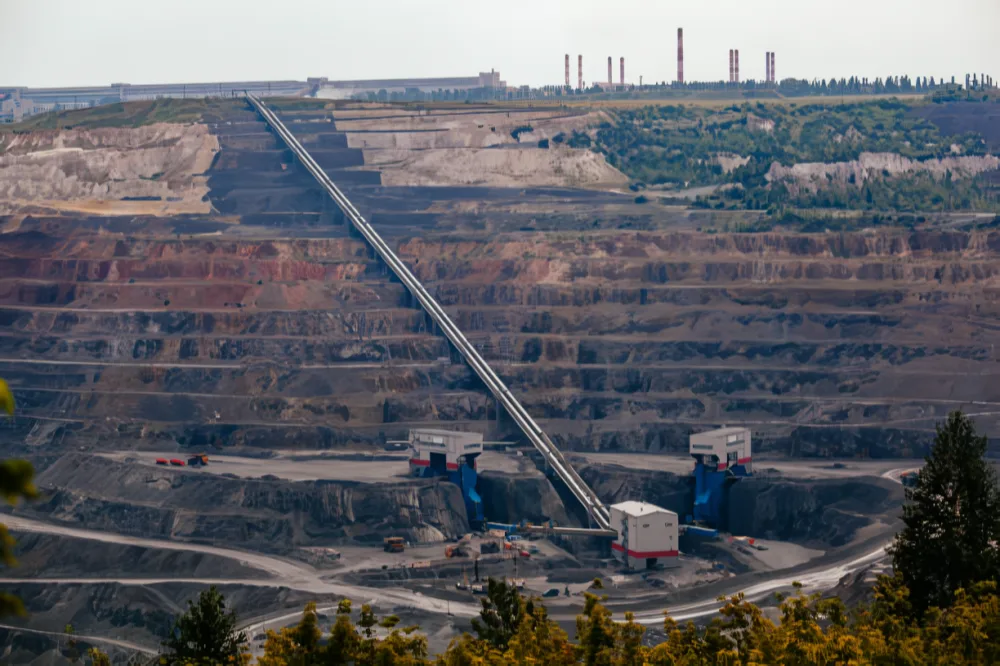
5. Sustainable development and energy-saving technologies
In the process of development, enterprises should not only consider how to improve production efficiency, but also pay more attention to reducing the impact on the environment. automated conveyor systems, as a key production tool, is also moving towards sustainable development through energy-saving technologies, environmentally friendly materials and resource recycling mechanisms, which can help enterprises to reduce their carbon footprints and improve their operational efficiencies.
5.1 Application of low-energy components
Every mechanical operation is a consumption of energy, and reducing this consumption has become a major theme in the development of conveyor system technology. Efficient motors and variable frequency drives are helping companies to optimize energy use and ensure that every part of the conveyor system is working in the most energy-efficient way possible.
The use of low-energy components in industrial production is widely popular. Particularly in automotive manufacturing and heavy-duty materials handling, energy-efficient motors and controllers dramatically reduce the energy consumption of conveyor systems while improving their operational efficiency. These intelligent devices are able to automatically adjust power output according to load, avoiding unnecessary energy waste and helping companies achieve higher standards of energy conservation.
5.2 Application of kinetic energy recovery system
The emergence of kinetic energy recovery technology provides more energy saving opportunities for automated conveyor systems. By recovering the kinetic energy generated when the system decelerates or stops while conveying materials, companies not only reduce energy consumption, but also optimize system efficiency.
In the mining industry, kinetic energy recovery systems have become a core technology for saving energy when conveying ore over long distances. This technology helps mining companies recycle excess energy from the material transfer process into the power grid, reducing reliance on external energy sources. In addition, by using kinetic energy recovery systems, logistics centers reduce energy waste when handling large numbers of packages and make the entire system more efficient.
5.3 Innovative application of environmentally friendly materials
Eco-friendly materials may have been a fashionable concept n years ago, but nowadays they are no longer fashionable and have found concrete applications in industrial manufacturing.
Polylactic acid (PLA): PLA is a biodegradable plastic that is commonly used in conveyor belt manufacturing in the food processing industry. It is made by fermenting plant sugars (e.g. corn starch) and possesses good heat and chemical resistance. Due to its renewable nature, PLA is a green alternative to conveyor belt materials in the food industry, able to biodegrade at the end of its useful life and reduce environmental pollution.
Thermoplastic Polyurethane (TPU): This material is widely used in electronics and medical device manufacturing. Not only does it offer excellent abrasion and chemical resistance, but it can also be recycled at the end of its useful life.TPU is used as a conveyor belt material in high-precision production lines, where its high elasticity and long-lasting durability make it an ideal alternative to traditional rubber and PVC materials.
Blends of natural and synthetic rubber: In the pharmaceutical industry, conveyor belt systems must meet strict hygiene standards. Blends of natural and synthetic rubber are the preferred choice for this industry. These materials not only reduce dependence on petrochemical resources during production, but also maintain stability in higher temperatures and chemical environments.
By introducing these environmentally friendly materials, companies are able to minimize the negative impact on the environment while ensuring long-lasting durability and efficient operation of their systems.
5.4 Enhancing market competitiveness through sustainable development strategies
The concept of sustainable development has been deeply rooted in people’s minds along with the promotion of the concept of environmental protection in various countries. Adopting the concept of sustainable development can not only help companies reduce the burden on the environment, but also create a new advantage in the highly competitive market, and even bring companies to strive for some excellent government policies. What are some of the specific measures that companies can take when developing an environmental strategy? Here do some simple distance.
Optimize energy management systems
Enterprises can monitor energy use in conveyor belt systems in real time by introducing intelligent energy management systems. These systems can dynamically adjust energy output according to production demand and reduce wasted energy consumption. For example, companies can use efficient energy monitoring software and hardware to identify and optimize energy-consuming aspects of the system to further improve energy efficiency.
Use an efficient maintenance and servicing program
Regular maintenance of a conveyor system not only improves the lifespan of the equipment, but also reduces energy consumption by optimizing the system’s operating conditions. Companies can reduce the increase in energy consumption due to equipment wear and tear or malfunction by introducing preventive maintenance programs. Through real-time monitoring and data analysis, companies can identify wear and tear trends early and repair problems before they become bigger, avoiding unnecessary energy waste.
Adoption of energy-saving conveyor belt materials and components
In terms of material and component selection, companies can choose conveyor belt materials with higher wear resistance and lower energy consumption. For example, using materials with high durability and low friction can reduce energy consumption during conveyor belt operation and extend the life of the equipment. By using heat-resistant or low-friction materials, many companies are making their systems more energy-efficient when operating in high-temperature, high-pressure environments, which not only meets environmental requirements, but also significantly reduces maintenance costs.
As these measures are gradually integrated into the daily operations of the company, the brand image and market influence will also be enhanced. So are these environmental strategies the very key to a company’s steady march forward in the future?
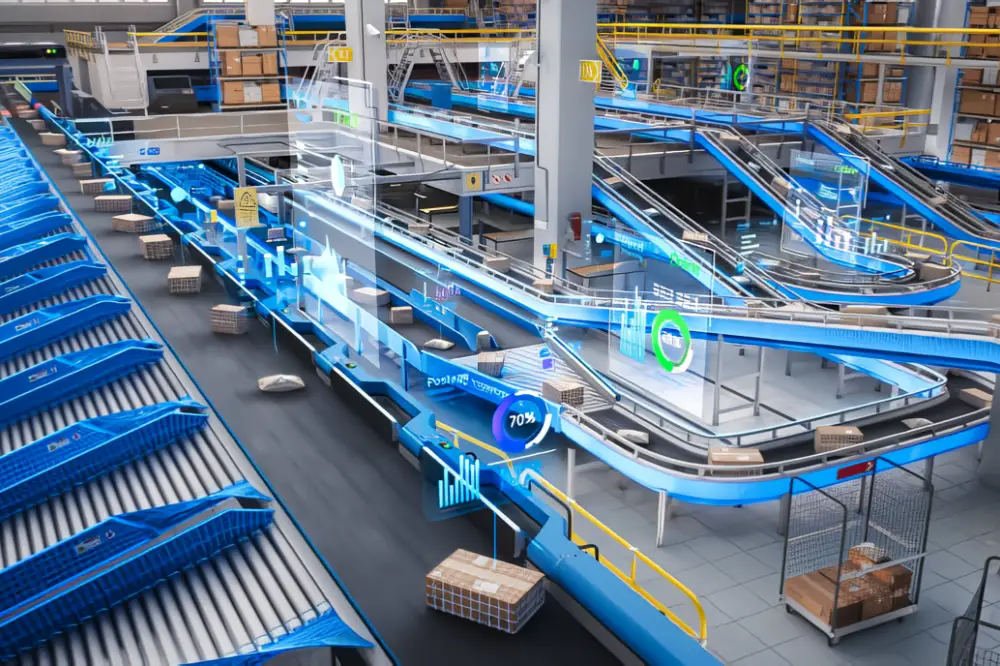
6. Raising safety standards: protection and operational security
In the age of industrial automation, automated conveyor systems are not only the pulse of production – they must also be the guardians of worker safety. Through efficient safety design and modern sensor technology, conveyor systems safeguard productivity while minimizing potential risks.
6.1 Safety Design in Conveyor Belt Systems
Safety design in conveyor belt systems acts as a strong fortress against accidents. When risks are unavoidable, the system’s multiple safety measures, such as emergency stop buttons, guardrails and safety locking systems, work quickly to protect operators.
The Emergency Stop button is not only a “lifesaver” in the plant, it is the first line of defense in the conveyor system. When equipment is out of order or people are approaching, pressing the button instantly cuts off power and stops all operation, preventing further injury. The guardrail and safety locking system is an intelligent design to ensure that operators do not unintentionally enter the danger zone, like a pair of invisible hands, always protecting the workers on site.
Modern conveyor belt systems also monitor the entire conveying process in real time through intelligent monitoring technology. Like an invisible guard, it monitors the running status of the equipment at any time. Once overheating, overloading and other abnormalities occur, the system will immediately issue an alarm and automatically take measures to protect the dual safety of equipment and personnel.
6.2 Modern sensor technology to improve security
If the traditional safety measures are “fortress”, then modern sensor technology is undoubtedly to give these fortresses “wisdom” of the source. With the help of sensors, the conveyor belt system can not only accurately detect the state of materials, but also real-time awareness of the activities of personnel, and actively avoid risks.
Infrared sensors, for example, are like “eyes” that monitor the distance between the operator and the conveyor belt. If the sensor detects a worker approaching the equipment, the system will automatically slow down or even stop to avoid accidents. Modern intelligent feedback systems take this process to the next level. Real-time data feedback can quickly adjust the speed and load of the conveyor belt, and even predict potential failures, as if it has a “sixth sense”, and has already taken proactive measures before an accident occurs.
With the support of sensing technology, conveyor systems have become smarter and safer. This not only allows workers to operate with greater peace of mind, but also reduces the risk of production interruptions, resulting in greater production stability for the organization.
6.3 Improved operational design for worker safety
A successful conveyor system must take into account not only the mechanical properties, but also the comfort and health of the operator. Ergonomic design is becoming a new trend in safeguarding worker safety, helping to reduce physical fatigue due to repetitive movements and prolonged labor.
For example, the use of low-friction thermoplastic polyurethane (TPU) materials not only improves the efficiency of conveyor belts, but also reduces the physical exertion of operators while operating the system. This material has high elasticity and abrasion resistance, which not only makes material transfer smoother, but also makes it easier for operators to adjust and repair equipment.
A large manufacturing company has greatly reduced worker fatigue when working at the equipment by introducing intelligent operator consoles and ergonomic consoles. Combined with a highly integrated intelligent feedback system, workers no longer need to manually operate or adjust the system as often, reducing the risk of occupational injuries due to repetitive operations.
These improvements not only demonstrate advantages in terms of mechanical performance, but also take operator safety and security to the next level.

7. Future prospects: innovative applications of existing technologies
Technology never stops moving, and automated conveyor systems are constantly adapting to this fast-paced world. In some ways, conveyor systems are being quietly revolutionized. Today, conveyor belts are no longer just material handling tools; they have begun to evolve into an intelligent, efficient production partner. The technology of the future will not only be limited to improving efficiency, but will also reshape the way companies operate, making sustainable development possible.
7.1 Future potential of kinetic energy recovery systems
Significant progress has been made in the automotive industry with kinetic energy recovery technology, which helps vehicles become more energy efficient by recovering the kinetic energy from deceleration and converting it into electrical energy. Similar to the automotive industry, kinetic energy recovery can be applied to automated conveyor systems to improve energy efficiency by recovering excess energy generated when a conveyor belt decelerates or stops.
In the future, kinetic energy recovery systems are expected to be utilized in more industrial production lines, especially in industries that rely on large-scale material transfer. Through further research and development, kinetic energy recovery systems will improve efficiency and reduce energy consumption, providing companies with a more environmentally friendly and efficient energy management solution. Although kinetic energy recovery technology is not a complete replacement for traditional energy sources, it offers a practical solution to reduce energy consumption and operating costs, helping companies move towards a more sustainable direction.
Successful practices in the automotive industry have shown that this technology not only extends the service life of equipment, but also significantly reduces energy wastage during system operation, and is expected to become a key energy-saving tool in conveyor systems in the future.
7.2 Future application of self-healing materials
Imagine a conveyor belt that is slightly worn out during use, but can “heal” itself without the need for manual maintenance. This is the marvel of self-healing materials. Breakthroughs in self-healing materials are revolutionizing the maintenance and service life of future conveyor belt systems.
At present, self-healing materials have already obtained preliminary results in the laboratory and will be widely used in industrial production in the future. Through nanomaterials technology, tiny cracks in conveyor belts can be repaired under pressure or heat, ensuring that the system can still run stably for a long time under high load conditions. This technology can help companies reduce equipment downtime, lower maintenance costs, and greatly extend the service life of conveyor systems.
This prospect can not help but remind people of another layer of meaning of automated production: not only the operation of automation, and even maintenance will be automated.
7.3 Development of intelligent maintenance systems
Intelligent maintenance systems are more than just “remote monitoring”, they will become the “personal doctor” of the production equipment. Through real-time data monitoring and feedback, companies can predict possible equipment failures in advance and take proactive maintenance measures before they occur.
Modern intelligent maintenance systems are already able to analyze the temperature, vibration, friction and other parameters of the conveyor belt in real time, and this technology will be more intelligent and accurate in the future. For example, some companies are already testing machine-learning-based intelligent maintenance systems that can predict when conveyor equipment is likely to fail based on past operational data and make timely adjustments or notify operators to perform maintenance.
In the future, these intelligent systems will not only enhance the life of the equipment, but also significantly reduce maintenance costs, allowing companies to further optimize the efficiency of equipment use while ensuring productivity.
7.4 Integration with Smart Grid
With the development of smart grid technology, future delivery systems will no longer just be energy consumers; they will be part of energy management. Conveyance systems will be able to integrate with smart grids to optimize energy consumption during power peaks and troughs through real-time energy management that automatically adjusts operating speeds and power output during fluctuations in power supply.
For example, during peak times, the conveyor system can temporarily reduce its operating speed to reduce power usage, while during trough times it can increase its speed to utilize lower electricity costs for efficient production. The smart grid of the future will not only help companies better balance their production needs with their power supply, but will also be able to save them significant amounts of money on their energy bills.
This technological integration will lead to more flexible energy management models, enabling companies to operate better in the complex electricity market and further enhance their sustainability.
